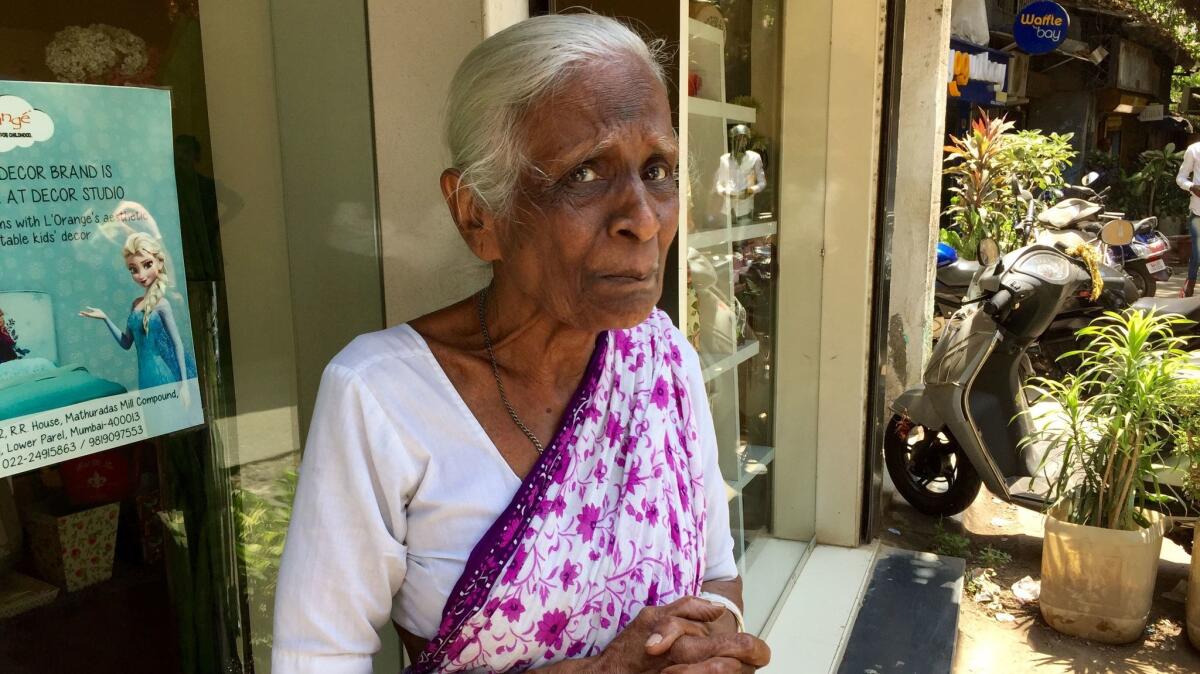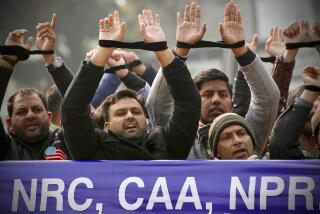India is building a biometric database for 1.3 billion people — and enrollment is mandatory

- Share via
Reporting from MUMBAI, India — Inside the buzzing enrollment agency, young professionals wearing slim-fitting jeans and lanyards around their necks tapped away at keyboards and fiddled with fingerprint scanning devices as they helped build the biggest and most ambitious biometric database ever conceived.
Into the office stepped Vimal Gawde, an impoverished 75-year-old widow dressed in a floral print sari. She had come to secure her ticket to India’s digital future — to enroll in the identity program, called Aadhaar, or “foundation,” that aims to record the fingerprints and irises of all 1.3 billion Indian residents.
Nearly 9 out of 10 Indians have registered, each assigned a unique 12-digit number that serves as a digital identity that can be verified with the scan of a thumb or an eye. But Gawde came to the enrollment office less out of excitement than desperation: If she didn’t get a number, she worried that she wouldn’t be able to eat.
Designed as a showcase of India’s technological prowess — offering identity proof to the poor and reducing waste in welfare programs — Aadhaar’s grand promises have been muddied by controversy as the government makes enrollment mandatory for a growing number of essential services.
Indians now need an Aadhaar number to pay taxes, collect pensions and obtain certain welfare benefits. The rapid expansion of a program that was originally described as voluntary has sparked criticism that India is vacuuming up citizens’ personal information with few privacy safeguards and creating hardship for the very people the initiative was supposed to help.
Like many Indians living in poverty, Gawde uses a ration card to purchase her monthly allotment of subsidized rice and cooking gas. But the shopkeeper told her that starting next month, he would sell to her only if she produced an Aadhaar number.
She had visited the enrollment agency three times but had yet to be approved, for reasons she did not understand. (Enrollment agents would not comment on individual cases.)
Reaching into her canvas bag, Gawde pulled out the familiar panoply of documents — ration card, voter card, electricity bill, income tax ID — that Indians use to navigate a dizzying bureaucracy. Aadhaar, she was told, would supplant all these papers.
But she had to get the number first.
“I’m nervous,” Gawde said outside the enrollment office on a sweltering morning. “I first applied three years ago and submitted all my documents, but didn’t follow up. Now that it’s becoming compulsory, I’m doing everything I can to get it.”
Indian Prime Minister Narendra Modi, who had criticized Aadhaar as a “political gimmick” before he took office, has embraced the futuristic idea of an all-in-one digital identity. His party pushed through a law last year that paved the way for a dramatic expansion of Aadhaar, allowing government entities and private businesses wide latitude to access the database, which collects not just people’s names and birth dates but also phone numbers, email addresses and other information.
Soon, as more private companies use the database, it could become difficult to open a bank account, get a new cellphone number or buy plane or train tickets without being enrolled.
Supporters say the program, which has cost about $1 billion to implement, will save multiples of that by curbing tax evasion and ensuring that welfare subsidies are not stolen by middlemen.
“Aadhaar was always meant to be an instrument of inclusion,” Nandan Nilekani, a tech billionaire and the program’s first chairman, said in an interview. “I’m really happy that the current government is completely endorsing Aadhaar and using it for a wide variety of services that will transform governance.”
Nilekani calls Aadhaar “hugely empowering” for the poor, but not long ago even he argued that enrollment should remain optional so that no Indians were prevented from accessing essential services. India’s Supreme Court agreed, ruling in 2015 that the government could not require Aadhaar for any benefit to which a person was otherwise entitled, as long as they could prove their identity by some other means.
Yet the court has stayed silent as Aadhaar creeps into every facet of Indian life, even for children.
A 12-year-old girl named Saiba is a case in point. After the girl’s grandmother passed away in their family’s ancestral village in northern India, Saiba’s mother moved her and her four siblings to a crowded neighborhood on the rough fringes of New Delhi, near a car parts market thick with the smell of grease.
When Saiba’s mother, Rani, went to the local school in April to register her for the sixth grade, administrators turned her down, saying every student must have an Aadhaar number.
But to get a number, a child usually needs a birth certificate — and like one-quarter of children born in this country, Saiba and her siblings did not have them because their village did not routinely register births.
Sitting with her mother in the cramped offices of the local advocacy group Pardarshita, above a noisy street lined with vegetable sellers, the girl puffed her round cheeks in an expression of helplessness.
“I don’t know anything about this,” said Saiba, who, like many Indians, has only one name. “I just want to go to school.”
Rakesh Thakur, a board member of Pardarshita, is trying to obtain Aadhaar numbers for dozens of children barred from Delhi schools. He called the policy “a clear violation” by the municipal government of both the Supreme Court order and India’s Right to Education Act, which guarantees every child younger than 14 free schooling.
A Twitter account called “Rethink Aadhaar” logs new instances almost daily of Indians who have suffered because scanners couldn’t read their fingerprints or because of errors in the database.
In Jawhar, a forested zone about 60 miles north of Mumbai, administrators have told local tribal communities that they will soon use Aadhaar to distribute welfare rations and school lunches. But the area lies outside cellphone range, leading residents to wonder how scanners will connect to the Internet to verify their identities.
“The idea of Aadhaar and the technology may be good, but do we have the infrastructure to make it mandatory?” said Vivek Pandit, a former lawmaker who runs a nonprofit group in the area. “The law is city-centric, and it would only lead to the social exclusion of rural India.”
This month lawyers opposing Aadhaar argued before the Supreme Court that the government could not force Indians to share their biometric data. Atty. Gen. Mukul Rohatgi countered that Indians had no constitutional right to privacy and could not claim an “absolute right” over their bodies.
Without privacy protections, activists worry that as Aadhaar numbers are linked to more and more services, intelligence agencies could use the database to more easily track Indians’ calls, travels and purchases.
“It’s become very clear that this is not a project about the poor,” said Usha Ramanathan, a lawyer and anti-Aadhaar activist. “The government’s ambitions have gotten greater over time.”
This month, the Center for Internet and Society, a New Delhi think tank, reported that federal and state agencies had published up to 135 million Aadhaar numbers — some including sensitive information such as a person’s caste and religion, or details of pension payments — on unsecured websites accessible through just a few clicks.
It’s become very clear that this is not a project about the poor.
— Usha Ramanathan, a lawyer and anti-Aadhaar activist
Pranesh Prakash, the center’s policy director, said that when Indian authorities can’t even keep Aadhaar numbers private, as the law requires, it suggests the entire database is vulnerable — particularly after sensitive information involving 22 million Americans was exposed when federal databases were hacked in 2015.
“When these kinds of leaks are happening, it’s rather foolhardy to maintain a database of 1.2 billion people’s biometrics, because once this gets breached, it becomes completely unusable,” Prakash said.
“If your PIN number or password leaks, you can change it. You can’t change your fingerprints.”
Praveen Chakravarty, a former investment banker who worked with Nilekani to launch Aadhaar, believes the lack of safeguards undermines the project’s ideals of efficiency and empowerment. He said many Indians were right to worry that Modi’s government, which has cracked down on political activists and nonprofit groups it opposes, could use Aadhaar to snoop on citizens.
“Maybe Aadhaar didn’t need to be this big,” Chakravarty said, adding that the government could simply have worked to fix inefficiencies in individual welfare programs.
“People could ask, ‘Did we need this at all?’” he said. “It’s a good question.”
For Gawde, the widow, Aadhaar remained an idea of the future. She left the enrollment agency that day empty-handed, told by a young employee that her number had not been assigned. But she retained hope that the new ID would make life easier.
“We are just poor people,” she said. “We have to trust what the government tells us.”
Special correspondent Parth M.N. contributed to this report.
Follow @SBengali on Twitter for more news from South Asia
ALSO
The Indian fantasy epic that’s breaking box-office records is unlike any Bollywood film you’ve seen
Cannibalism, prostitution and other racist myths that confront Africans studying in India
More to Read
Sign up for Essential California
The most important California stories and recommendations in your inbox every morning.
You may occasionally receive promotional content from the Los Angeles Times.











